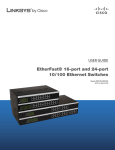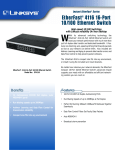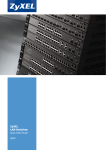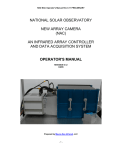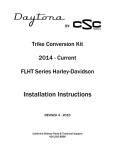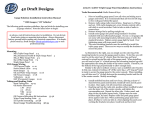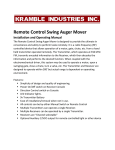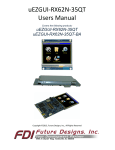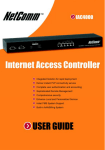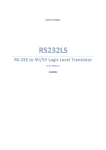Download Linksys EF3116 Switch User Manual
Transcript
COPYRIGHT & TRADEMARKS Copyright © 2003 Linksys, All rights reserved. Instant EtherFast and Linksys are registered trademarks of Linksys. Microsoft, Windows, and the Windows logo are registered trademarks of Microsoft Corporation. All other trademarks and brand names are the property of their respective proprietors. LIMITED WARRANTY Linksys guarantees that every Instant EtherFast® EtherFast® 16-Port and 24-Port 10/100 Ethernet Switch is free from physical defects in material and workmanship for two years, when used within the limits set forth in the Specifications section of this User Guide. If the product proves defective during this warranty period, call Linksys Customer Support in order to obtain a Return Authorization number. BE SURE TO HAVE YOUR PROOF OF PURCHASE ON HAND WHEN CALLING. RETURN REQUESTS CANNOT BE PROCESSED WITHOUT PROOF OF PURCHASE. When returning a product, mark the Return Authorization number clearly on the outside of the package and include your original proof of purchase. All customers located outside of the United States of America and Canada shall be held responsible for shipping and handling charges. IN NO EVENT SHALL LINKSYS’ LIABILITY EXCEED THE PRICE PAID FOR THE PRODUCT FROM DIRECT, INDIRECT, SPECIAL, INCIDENTAL, OR CONSEQUENTIAL DAMAGES RESULTING FROM THE USE OF THE PRODUCT, ITS ACCOMPANYING SOFTWARE, OR ITS DOCUMENTATION. Linksys makes no warranty or representation, expressed, implied, or statutory, with respect to its products or the contents or use of this documentation and all accompanying software, and specifically disclaims its quality, performance, merchantability, or fitness for any particular purpose. Linksys reserves the right to revise or update its products, software, or documentation without obligation to notify any individual or entity. Please direct all inquiries to: Linksys P.O. Box 18558, Irvine, CA 92623. FCC STATEMENT This equipment has been tested and found to comply with the limits for a Class A digital device, pursuant to Part 15 of the FCC Rules. These limits are designed to provide reasonable protection against harmful interference in a residential installation. This equipment generates, uses, and can radiate radio frequency energy and, if not installed and used according to the instructions, may cause harmful interference to radio communications. However, there is no guarantee that interference will not occur in a particular installation. If this equipment does cause harmful interference to radio or television reception, which is found by turning the equipment off and on, the user is encouraged to try to correct the interference by one or more of the following measures: • • • • Reorient or relocate the receiving antenna Increase the separation between the equipment or device Connect the equipment to an outlet other than the receiver’s Consult a dealer or an experienced radio/TV technician for assistance UG-EF3116_24 & 4116_24-010303A KL EtherFast® 16-Port and 24-Port 10/100 Ethernet Switches Table of Contents Chapter 1: Introduction The Linksys Instant EtherFast® EtherFast® 10/100 Ethernet Switches Chapter 1: Introduction The Linksys Instant EtherFast® EtherFast® 10/100 Ethernet Switches Features Package Contents 1 1 1 2 Chapter 2: Hardware Installation Planning Your Network Installing an Ethernet Switch Reading an Ethernet Switch’s LED Display Tips on Switching Your Network 3 3 4 6 7 Appendix A: Fiber Optic Modules (models EF3116 & EF3124 ONLY) Introduction Installing a Fiber Optic Expansion Module Reading a Fiber Module’s LED display 8 8 8 10 Appendix B: About Fast Ethernet The History of Fast Ethernet Switches Versus Hubs 11 11 11 Appendix C: Glossary 13 Appendix D: Specifications EF3116/EF3124 EF4116/EF4124 18 18 18 • Appendix E: Environmental EF3116/EF3124 EF4116/EF4124 19 19 19 • • • • • Appendix F: Warranty Information 20 Appendix G: Contact Information 21 With advanced switching technology, the EtherFast® 10/100 Ethernet Switches will boost your network performance with much more than just full duplex data transfer and dedicated bandwidth. They feature non-blocking, wire-speed switching that forwards packets as fast as your network can deliver them. Also included are Address Learning and Aging to prevent data transfer errors and Data Flow Control to help prevent packet collisions. The rack mountable switches include an Expansion Port that accepts an optional Fiber Module to let you grow your network by linking to other switches in full duplex mode up to 2000 meters (6560 feet) away. The compact switches are small enough to fit into any crowded office. No matter how intensive your network demands, the EtherFast® 10/100 Ethernet Switches advanced chipsets support your needs with an affordable and efficient networking solution you can count on. Features • • • • 16 or 24 autosensing 10/100 full duplex, auto MDI/MDI-X ports Some models feature optional 100BaseFX Fiber Optic Modules to connect multiple switches at high speed as your network grows Run blazing speeds up to 200Mbps Address Learning and Aging and Data Flow Control for enhanced transmission reliability Perfect for Running 10BaseT, 100BaseTX and 100BaseFX Hardware Together Seamlessly Data Flow Control Filters Out Faulty Data Packets Auto MDI/MDI-X Supports aging function, 802.3x Pause Frame for full duplex Head of Line (HOL) blocking prevention Broadcast storm control avoids unnecessary bandwidth absorption 1 Instant EtherFast® Series EtherFast® 16-Port and 24-Port 10/100 Ethernet Switches Chapter 2: Hardware Installation Package Contents Planning Your Network Building a Fast Ethernet network involves a few more topology rules in addition to 10BaseT network rules. These rules specify distance limitations and cabling specifications. Data loss, collisions, and other network problems causing down time are likely to result if the rules below are not followed. • Use UTP Category 5 (EIA 568B, Cat 5) ethernet cabling with four twistedpair wires and RJ-45 tips for all Fast Ethernet connections. • Use the chart below to position any switches, hubs and workstations. Figure 1-1 • • • • EtherFast® 16-Port or 24-Port 10/100 Ethernet Switch (Only ONE Switch included) AC Power Cable User Guide and Registration Card Mounting kit containing: Four rubber feet for mounting an Ethernet Switch on a table Two mounting brackets Six screws for attaching the brackets to a rack (not shown) From To Maximum Distance Switch Switch or Hub* 100 meters (328 feet) Hub* Switch or Hub* Hub* Workstation 5 meters (16.4 feet) 100 meters (328 feet) *Hub refers to any type of 100Mbps hub, including regular hubs and stackable hubs. A 10Mbps hub linked to another 10Mbps hub or a 10/100 hub can span up to 100 meters (328 feet). • No more than two hubs should be uplinked in a row in a Fast Ethernet network. A set of stacked hubs, which must be stacked with a stacking cable, counts as one hub or node on the network. • In Fast Ethernet, an Ethernet Switch acts as a repeater, regenerating data signals before passing them on to the next device. Hubs cannot act as repeaters. 2 3 Instant EtherFast® Series Configuration A shows one possible way to set up an Ethernet Switch in a Fast Ethernet environment. Note that an Ethernet Switch requires UTP Category 5 network cabling for all its connections, like all Fast Ethernet network hardware. All of the workstations below can access all resources on the network - 10Mbps users can access the 100Mbps nodes, and vice versa. While allowing the 10Mbps and 100Mbps segments to communicate, an Ethernet Switch optimizes data traffic by switching the data packets to their destination through the quickest route possible, which improves performance up to 80% even on the faster 100Mbps network segment. EtherFast® 16-Port and 24-Port 10/100 Ethernet Switches Installing an Ethernet Switch Rack Mounting an Ethernet Switch Each Ethernet Switch is equipped with three mounting holes on each side for rack mounting in a standard rack. After screwing a mounting bracket into each side of an Ethernet Switch, lift the Switch into your rack and secure the brackets in place with additional screws (not supplied by Linksys). Connecting Nodes to an Ethernet Switch An Ethernet Switch’s front panel has 16 or 24 standard RJ-45 ports, depending upon the model, which can connect to workstations, file servers, print servers, and other network peripherals. Each port automatically detects port speed and can operate in either half or full duplex mode. With duplex detection, you can run speeds of 10Mbps, 20Mbps, 100Mbps, up to a maximum of 200Mbps. Configuration A Each cable connected to an Ethernet Switch must be a UTP Category 5 ethernet network cable with RJ-45 tips, and must not exceed 100 meters (328 feet) in length. Ready-to-use network cabling with precrimped ends are available at most computer retail stores. Connecting PCs Connect your PCs to an Ethernet Switch’s ports with straight-through UTP Category 5 cabling. Plug the other end of the Cat 5 cable into your PC’s network adapter. Connecting to Other Switches, Hubs, Bridges and Repeaters Each port on an Ethernet Switch can also be used to uplink to another switch, hub, bridge or repeater, serving as an uplink port. These ports will automatically detect what kind of cable is connected, either cross-over or straightthrough, and adjust for that cable. Figure 2-1 4 5 Instant EtherFast® Series EtherFast® 16-Port and 24-Port 10/100 Ethernet Switches Powering On an Ethernet Switch Tips on Switching Your Network Plug in an Ethernet Switch's AC power cable. The Switch will first run a diagnostic Self-Test, which just takes a few seconds. After the test, the Power LED will light up to indicate that the unit is powered on. As each node is powered on, the corresponding port’s Link/Activity (Link/Act) LED will light up. Here are some of the ways an Ethernet Switch can help you optimize your network speed. When data is transmitted or received, the Link/Act LEDs will flicker. Reading an Ethernet Switch’s LED Display • Speed up Nodes From Your 10BaseT Network In a 10BaseT network, connect your hubs, file servers and key users such as managers and network administrators directly to an Ethernet Switch to channel dedicated bandwidth in full duplex mode to each station. An Ethernet Switch can communicate with all its connections simultaneously. • Conserving Bandwidth with 10Mbps & 100Mbps Segments 10BaseT and 100BaseTX hardware are not readily compatible, but an Ethernet Switch can designate network segments of different speeds. This allows you to run one 10Mbps segment to serve users without a need for considerable speed, and a faster 100Mbps segment devoted to users who depend heavily on multimedia, database, gaming, or other speed-intensive applications. With switched segmentation, your 100Mbps users will not lose efficiency because of the 10Mbps segment’s transfer speed. Figure 2-2 An Ethernet Switch’s LED Display has a Power LED to indicate when the unit is ON. There are two LEDs per port: the Link/Activity (Link/Act) LED and the Full Duplex/Collision (FDX/Col) LED. (An example of the LEDs is shown in Figure 2-2. The LEDs on the switch you purchased may vary slightly.) See the chart below to find out what the status of each LED denotes. Front Panel LED Displays LEDs Network Status LEDs Color Status Link/Act Green Solid light Blinkinglight FDX/Col Yellow Solid light Power 6 Green Connection Established Transmitting/Receiving Full duplex transfer mode Blinking light Collision Solid light Displays power status • Run 10Mbps Peripherals in Your Fast Ethernet Network Most of the network peripherals in place today run at 10Mbps, since 10BaseT has been the standard network speed to date. These peripherals, designed to operate at 10Mbps, cannot readily communicate with 100Mbps equipment. A 10Mbps interface is also required for cable and DSL connections, which are quickly becoming very popular. An Ethernet Switch gives your 10BaseT equipment and cable and DSL lines a 10Mbps interface while still running your Fast Ethernet equipment at 100Mbps. • Strengthen Data Transfers Through Signal Regeneration An Etherfast Switch functions as a repeater, which regenerates data signals as they pass through it. This feature acts as a safeguard to deter data loss and ensure that transmissions arrive at their destination intact. Switches positioned between hubs can preserve your data’s integrity and eliminate your need to buy and use repeaters in your Fast Ethernet network. 7 Instant EtherFast® Series Appendix A: Fiber Optic Modules (models EF3116 & EF3124 ONLY) EtherFast® 16-Port and 24-Port 10/100 Ethernet Switches 4. Secure the fiber module with the screws from the faceplate. You may now remount the Switch into its rack if needed, then reconnect the AC power cable to power on the Switch and resume normal operation. 5. Install your multimode fiber optic cabling from the module. Important: Fiber Optic Modules will only function with model numbers: EF3116 and EF3124. If you are not sure of the Switch’s model number, make sure there is a fiber optic module port in the front of the Switch. If it does not have a fiber optic module port, your Switch will not function with Fiber Optic Modules. Introduction Some Ethernet Switches are equipped with an expansion port for adding optional fiber optic expansion modules. Use the guidelines below to plan the layout of your network with other fiberequipped devices from your Switch’s 100BaseFX fiber module. 100BaseFX Fiber Cabling Distance Limitations From The Ethernet Switch To Duplex Maximum Distance Switch or Distance Extender Full 2000 meters (6560 feet) Half 412 meters (1350 feet) Fiber Half only* 208 meters (682 feet) Transceiver The 100BaseFX Fiber Modules allow you to connect the Ethernet Switch to other switches, hubs, or routers in fiber optic network backbones. These modules use high-bandwidth, multimode fiber optic cabling with SC type connectors. Note: The Switch’s fiber module will not run with Gigabit devices. * A distance extender has an internal switch, whereas a transceiver does not. Switches generally use distance extenders, and hubs utilize both types of modules. Fiber cabling can transmit your Switch’s data up to 2000 meters (6560 feet) away to another switch without requiring signal regeneration. The 100BaseFX SC Fiber Module (model number EF31SC) is available through your Linksys dealer. Installing a Fiber Optic Expansion Module To install a fiber module into the Ethernet Switch’s expansion port, follow these instructions: 1. Before installing the fiber optic module, you must first power off the Switch by removing the AC power cord. If the Switch is rack mounted, you should remove the Switch from the rack temporarily until the fiber optic module is installed. 2. Remove the faceplate from the unit by loosening the screws on either side with a screwdriver. Remove the expansion module from its packaging. Keep the screws for securing the fiber module to the Switch in step 4. 3. Slide your fiber expansion module into the Switch. The module should fit snugly into the Switch’s expansion port. 8 9 Instant EtherFast® Series The fiber module does not autosense, so you must set it to run at either full or half duplex. Prior to installing the fiber module into the expansion port, use the jumpers on the card as shown in Figure A-1. EtherFast® 16-Port and 24-Port 10/100 Ethernet Switches Appendix B: About Fast Ethernet History of Fast Ethernet Standard Ethernet has been the most popular networking technology during this past decade, with a maximum data throughput of 10Mbps. But this Ethernet speed standard has fallen out of favor as today’s massive graphics, multimedia, and other data-intensive applications have magnified the problem of lagging network speed. Fast Ethernet now dominates as the most viable and economical solution to resolve the problem of network speed over all other market alternatives. Capable of sending and receiving data at 100 Mbps, its bandwidth more than accommodates even the most intensive real-time applications. Also known as 100BaseTX, Fast Ethernet supports high speed signaling and gives users an efficient and affordable solution for upgrading their present network to the upcoming standard speed of 100Mbps. 100BaseTX data packet lengths and formats are transmitted over two pairs of UTP Category 5 cabling, just like the 10BaseT system. It also uses identical data error control and management information as 10BaseT transmission. Figure 2-2 Changing connectors must be done professionally with the proper tools. If this is your first time working with fiber, consult a networking professional who is familiar with fiber. Reading a Fiber Module’s LED Display A Fiber Module’s LED Display has two LEDs: the Link/Activity (Link/Act) LED and the Full Duplex/Half Duplex (FDX) LED. See the chart below to find out what the status of each LED denotes. Front Panel LED Displays LEDs Network Status LEDs Color Blinkinglight Yellow Solid light No light 10 Switches versus Hubs An Ethernet Switch boosts your network performance several times over, conserving your time, money and resources. The scalability of an Ethernet Switch, its full duplex data transfer and dedicated bandwidth, all contribute to maximizing efficiency in your Fast Ethernet network. Status Link/Act Green Solid light FDX Because Fast Ethernet is based on similar technology as standard Ethernet, the issue of migrating from 10Mbps to the higher Fast Ethernet speed of 100Mbps requires virtually no effort with the right piece of equipment. All it takes is an Ethernet Switch to coordinate your network hardware, and you’re ready to run a top-notch system. Connection Established Transmitting/Receiving Full duplex transfer mode Half duplex transfer mode 11 Instant EtherFast® Series An Ethernet Switch’s autosensing feature gives you a key advantage over other forms of networking by upgrading speed-critical network segments to 100Mbps while allowing existing 10BaseT subnetworks to operate within it. Running 10BaseT and 100BaseTX hardware speeds alongside each other in an Ethernet Switch eliminates the need to purchase new hardware, rewire, and reconfigure an entire site all at once. This scalability factor ensures that Fast Ethernet will not fall obsolete to upgrades in speed standards and maintains use of all your old equipment until you decide to buy speedier replacements. Otherwise, throwing away all your older, slower equipment in an old-fashioned “forklift upgrade” is the only other alternative. Scalability allows you to budget for your networking needs over time. Now networks can custom-run fast and slow segments at the same time for different users or departments. Publishing, R&D, video, and accounting departments can enjoy a blazing 100Mbps transfer, while other corporate segments conserve bandwidth by operating at more economical 10Mbps speeds. Switches also feature full duplex data transfer, meaning that all computers on the switch can “talk” to the switch at the same time. Plus, switches are able to send and receive data simultaneously to all connections, whereas a hub cannot. A hub simply works with one computer at a time, and only sends or receives data, since it cannot handle two way communication. 12 EtherFast® 16-Port and 24-Port 10/100 Ethernet Switches Appendix C: Glossary 10BaseT - An Ethernet standard that uses twisted wire pairs. 100BaseTX - IEEE physical layer specification for 100 Mbps over two pairs of Category 5 UTP or STP wire. Adapter - Printed circuit board that plugs into a PC to add to capabilities or connectivity to a PC. In a networked environment, a network interface card (NIC) is the typical adapter that allows the PC or server to connect to the intranet and/or Internet. Backbone - The part of a network that connects most of the systems and networks together and handles the most data. Bandwidth - The transmission capacity of a given facility, in terms of how much data the facility can transmit in a fixed amount of time; expressed in bits per second (bps). Bit - A binary digit. The value - 0 or 1-used in the binary numbering system. Also, the smallest form of data. In addition to full duplex transfer, an Ethernet Switch surges your network with dedicated bandwidth to each node, devoting 100Mbps to every device and multiplying your bandwidth for each added node. For instance, if you connect five computers, capable of running at 100 Mbps, to an Ethernet Switch, then each computer will get a dedicated bandwidth of 200Mbps in full duplex transfer mode. If you run the same computers from a 100Mbps hub, then each computer would only share a part of the bandwidth, depending on how many other computers are running on the network, and how data-intensive the workload. Bridge - A device that interconnects different networks together. A network without a switch is called a shared network because every node on the network competes for a fraction of the total bandwidth. In a shared network, data packets are randomly broadcasted to all stations until they discover their intended destination. Consequently, considerable time and bandwidth is wasted on data packets traveling along network lines before they find their correct address. A switch, on the other hand, features a store-and-forward function which retains the address for each data packet and shoots them straight to the correct destination. CPU (Central Processing Unit) - The computing part of the computer. Also called the "processor," it is made up of the control unit and ALU. CAT 5 - ANSI/EIA (American National Standards Institute/Electronic Industries Association) Standard 568 is one of several standards that specify "categories" (the singular is commonly referred to as "CAT") of twisted pair cabling systems (wires, junctions, and connectors) in terms of the data rates that they can sustain. CAT 5 cable has a maximum throughput of 100 Mbps and is usually utilized for 100BaseTX networks. Database - A database is a collection of data that is organized so that its contents can easily be accessed, managed, and updated. Data Packet - One frame in a packet-switched message. Most data communications is based on dividing the transmitted message into packets. For example, an Ethernet packet can be from 64 to 1518 bytes in length. 13 Instant EtherFast® Series DSL (Digital Subscriber Line) - A technology that dramatically increases the digital capacity of ordinary telephone lines into the home or office and, by employing unused bandwidth, still allows for normal phone usage. DSL provides "always-on" operation, eliminating the need to dial in to the service. Ethernet - IEEE standard network protocol that specifies how data is placed on and retrieved from a common transmission medium. Has a transfer rate of 10 Mbps. Forms the underlying transport vehicle used by several upper-level protocols. Fast Ethernet - A 100 Mbps technology based on the 10Base-T Ethernet CSMA/CD network access method. Fiber Optic - The medium and the technology associated with the transmission of information as light impulses along a glass or plastic wire or fiber. Fiber optic wire carries much more information over longer distances than conventional copper wire and is far less subject to electromagnetic interference. Fiber Optic Cable - A transmission medium that uses glass or plastic fibers rather than copper wire to transport data or voice signals. The signal is imposed on the fibers via pulses (modulation) of light from a laser or a light-emitting diode (LED). Because of its high bandwidth and lack of susceptibility to interference, fiber optic cable is used in long-haul or noisy applications. EtherFast® 16-Port and 24-Port 10/100 Ethernet Switches IEEE (The Institute of Electrical and Electronics Engineers) - The IEEE describes itself as "the world's largest technical professional society, promoting the development and application of electrotechnology and allied sciences for the benefit of humanity, the advancement of the profession, and the well-being of our members." The IEEE fosters the development of standards that often become national and international standards. The organization publishes a number of journals, has many local chapters, and several large societies in special areas, such as the IEEE Computer Society. IGMP (Internet Group Management Protocol) - A multicast host registration protocol that allows any host to inform its local router that it wants to receive transmissions addresses to a specific multicast group. If there is more than one multicast router on a given subnetwork, one of the routers is elected "querier" and assumes the responsibility of keeping track of group membership. Mbps (Megabits per second) - One million bits per second; unit of measurement for data transmission. Network - A system that transmits any combination of voice, video and/or data between users. Full Duplex - The ability of a device or line to transmit data simultaneously in both directions. NIC (Network Interface Card) - A board installed in a computer system, usually a PC, to provide network communication capabilities to and from that computer system. Also called an adapter. Half Duplex - Data transmission that can occur in two directions over a single line, but only one direction at a time. Node - A network junction or connection point, typically a computer or work station. Hardware - Hardware is the physical aspect of computers, telecommunications, and other information technology devices. The term arose as a way to distinguish the "box" and the electronic circuitry and components of a computer from the program you put in it to make it do things. The program came to be known as the software. Packet - A unit of data routed between an origin and a destination in a network. Hub - The device that serves as the central location for attaching wires from workstations. Can be passive, where there is no amplification of the signals; or active, where the hubs are used like repeaters to provide an extension of the cable that connects to a workstation. Port - A pathway into and out of the computer or a network device such as a switch or router. For example, the serial and parallel ports on a personal computer are external sockets for plugging in communications lines, modems and printers. Print Server - A hardware device that enables a printer to be located anywhere in the network. RJ-45 (Registered Jack-45) - A connector similar to a telephone connector that holds up to eight wires, used for connecting Ethernet devices. 14 15 Instant EtherFast® Series Router - Protocol-dependent device that connects subnetworks together. Routers are useful in breaking down a very large network into smaller subnetworks; they introduce longer delays and typically have much lower throughput rates than bridges. Server - Any computer whose function in a network is to provide user access to files, printing, communications, and other services. EtherFast® 16-Port and 24-Port 10/100 Ethernet Switches UTP - Unshielded twisted pair is the most common kind of copper telephone wiring. Twisted pair is the ordinary copper wire that connects home and many business computers to the telephone company. To reduce crosstalk or electromagnetic induction between pairs of wires, two insulated copper wires are twisted around each other. Each signal on twisted pair requires both wires. Since some telephone sets or desktop locations require multiple connections, twisted pair is sometimes installed in two or more pairs, all within a single cable. Software - Instructions for the computer. A series of instructions that performs a particular task is called a "program." The two major categories of software are "system software" and "application software." System software is made up of control programs such as the operating system and database management system (DBMS). Application software is any program that processes data for the user. A common misconception is that software is data. It is not. Software tells the hardware how to process the data. STP (Shielded Twisted Pair) - Telephone wire that is wrapped in a metal sheath to eliminate external interference. Switch - 1. A data switch connects computing devices to host computers, allowing a large number of devices to share a limited number of ports. 2. A device for making, breaking, or changing the connections in an electrical circuit. Throughput - The amount of data moved successfully from one place to another in a given time period. Topology - A network's topology is a logical characterization of how the devices on the network are connected and the distances between them. The most common network devices include hubs, switches, routers, and gateways. Most large networks contain several levels of interconnection, the most important of which include edge connections, backbone connections, and wide-area connections. TX Rate - Transmission Rate. Upgrade - To replace existing software or firmware with a newer version. Upload - To transmit a file over a network. In a communications session, upload means transmit, download means receive. 16 17 Instant EtherFast® Series EtherFast® 16-Port and 24-Port 10/100 Ethernet Switches Appendix D: Specifications Appendix E: Environmental EF3116/EF3124 EF3116/EF3124 Specifications Dimensions 7 .1” x 1.75” x 16.93” 180mm x 44.5mm x 430mm Standards IEEE 802.3, IEEE 802.3u, IEEE 802.1p, IEEE 802.3x Ports 16 or 24 10/100 Auto-Negotiation RJ-45 Ports One Fiber Module Expansion Port Power Input 100-240V AC, 50-60Hz Speed Per Port 10Mbps or 100Mbps (Half Duplex) 20Mbps or 200Mbps (Full Duplex) Certifications FCC Class A, CE Cabling Type UTP/STP Category 5 or Better Operating Temperature 0ºC to 50ºC (32ºF to 122ºF) LEDs Power Link/Activity (per port) Full Duplex (per port) Storage Temperature -40ºC to 70ºC (-40ºF to 158ºF) Operating Humidity 20% to 95%, Non-Condensing Storage Humidity 20% to 95%, Non-Condensing Weight EF4116 5.51 lbs. (2.5kg) EF4116 6.61 lbs. (3.0kg) EF4116/EF4124 Standards IEEE 802.3, IEEE 802.3u, IEEE 802.3x Ports 16 or 24 10/100 Auto-Negotiation RJ-45 Ports EF4116/EF4124 Dimensions Speed Per Port 10Mbps or 100Mbps (Half Duplex) 20Mbps or 200Mbps (Full Duplex) Weight Cabling Type UTP/STP Category 5 or Better LEDs Power Link/Activity (per port) Full Duplex/Collision (per port) 6.69” x 1.77” x 10.51” 170mm x 45mm x 267mm EF4116 2.65 lbs. (1.2kg) EF4124 2.87 lbs. (1.3kg) Power Input 100-240V AC, 50-60Hz Certifications FCC Class A, CE Operating Temperature 0ºC to 50ºC (32ºF to 122ºF) 18 Storage Temperature -40ºC to 70ºC (-40ºF to 158ºF) Operating Humidity 20% to 95%, Non-Condensing Storage Humidity 20% to 95%, Non-Condensing 19













